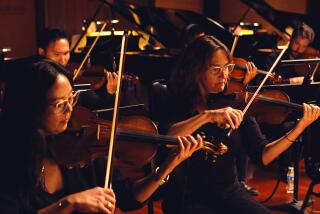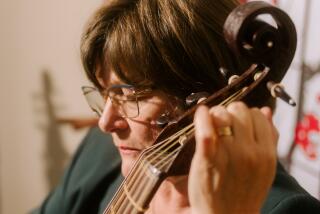MUSIC AND INSTRUMENTS
- Share via
Throughout history, people have used their voices to make music. And almost all cultures have created music with instruments, from synthesizers to wooden sticks, from guitars to gourds. Music is the universal language. Today, we can hear music in our homes and cars, in elevators and offices, at the movies, on television and at concerts. To learn more about music, use the direct links on The Times Launch Point Web site:
http://pyxis.nohib.com/launchpoint/
Here are the best sites for getting your schoolwork done or for just having fun.
LEVEL 1
Learn to Read Music: You have to understand the symbols on the page before you can read music. This site explains notes, rests, clefs, time signatures and how to count rhythms.
https://www.gspyo.com/education/html/intro.html
Make Your Own Instrument: Many instruments can be made from objects you have at home. Learn how to make a cardboard kazoo, glass-bottle xylophone and bongos.
https://www.interlog.com/~brucem/make.html
Learn About Instruments: Do you know the difference between a violin and a viola? A cello and a bass? Acquaint yourself with the instruments of the orchestra by using this illustrated guide.
https://www.gspyo.com/education/html/instr-intro.html
LEVEL 2
Music World for Kids: What is a rhythm and a pitch? How do you count half steps or whole steps on a piano? Learn all of this and more while listening to various beats.
https://members.aol.com/muswrld/
The Virtual Piano Museum: Learn the origins of the modern-day piano through pictures and descriptions of some important pianos in history.
https://www.ptg.org/museum/musefram.htm
The Piano Education Page--Just for Kids: Read imaginary “conversations” with such composers as Schubert, Mozart, Chopin and Listz. Ask a piano teacher your music questions by e-mail. Learn tips to improve your piano playing and enjoy your lessons. A Spanish version of this site is also available.
English: https://www.unm.edu/~loritaf/pnokids.html
Spanish: https://www.unm.edu/~loritaf/pepesp/pnokidse.html
LEVEL 3
Encarta--Music: An excellent overview explaining what music is, what specific musical terms mean and which instruments are used to produce what sounds. Includes links to articles on African American, Chinese, Japanese, Latin American and Native American music.
https://encarta.msn.com/find/concise/
default.asp?vs=x97&la;=na&ty;=1&vo;=23&ti;=043dc000
Temple University Dictionary of Composers: Find out more about famous composers through this index of biographies organized alphabetically or by musical period.
https://www.temple.edu/music/composers/composers.html
International Music Archives: Explore musical styles and instruments from around the world through photographs, sound samples and descriptions. https://www.eyeneer.com/World/index.html
Launch Point is produced by the UC Irvine department of education, which reviews each site for appropriateness and quality. Even so, parents should supervise their children’s use of the Internet. This week’s column was designed by Bernadette Zamora, Tinh Tran, Stan Woo-Sam and Anna Manring.
EXPLORER’S QUEST
The answer to this Internet quiz can be found in the sites at right.
QUESTION:
What makes up a major scale?
Clue: See Music World for Kids
Tell Us What You Want to Know
Have a paper or project coming up? Just curious about something? Send us a topic, and we’ll consider it for a Launch Point column. Write to us at The Times Orange County, 1375 Sunflower Ave., Costa Mesa, CA 92626. E-mail us at [email protected] or leave a phone message at (714) 966-4550.
Answer to last week’s Quest:
Winslow Homer’s painting “Snap the Whip” depicts children playing in springtime.
More to Read
The biggest entertainment stories
Get our big stories about Hollywood, film, television, music, arts, culture and more right in your inbox as soon as they publish.
You may occasionally receive promotional content from the Los Angeles Times.










